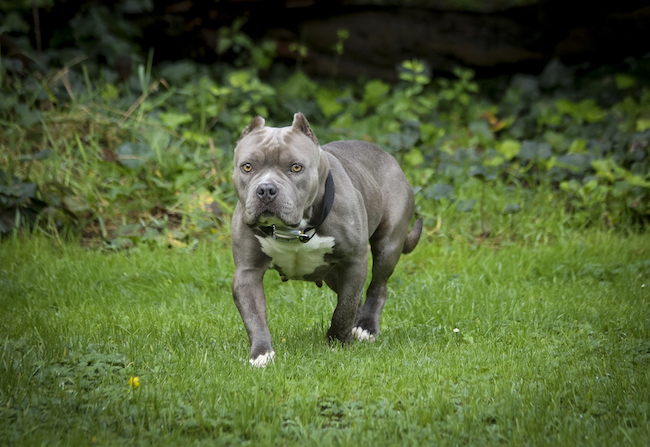Canines do hold the title of “man’s best friend,” but not all dogs are created equal. Some pups were bred to be lap dogs, therapy pets, service dogs, companions for kids, families and small animals. Other dogs were bred as protectors, guard dogs, hunters, herders, trackers, police dogs, and fighters. Even though some of these breeds might have the impression of being friendly and well-behaved, bear in mind that certain pooches require a lot more training and discipline than others. If you are particularly drawn to a dog breed on this list, but have little experience navigating the jungles of dog-training, think long and hard before making your selection. Training these breeds is not a job for the faint of heart.

Pit Bull: This breed is exceptionally popular for people who want to feel they have a protective guard dog in their home. But oftentimes they wind up putting the family in greater danger than any hypothetical thieves ever face. When it comes to threatening dogs, there is no competition; the Pit Bull has the highest number of child-attacks and owner assaults of any other dog breed. Though they can seem cuddly, docile and even charming, their fighter-mentality and rebellious tendencies make them a dangerous pet for inexperienced dog handlers. One of the worst mistakes people make is falling in love with a cute Pit, only to treat him as any other dog breed. Because the Pit Bull has a proven record of surprising misconduct, he must be guided with a firm hand, taught to submit and obey someone who understands what warning signs lead to accidents in the future. First-time pet owners, this breed is NOT for you!

Border Collie: Yes these dogs are the MOST intelligent breed, and are known to be hard workers. Consequently they take a lot of work in training. Their high intelligence and endless energy demands a very active lifestyle, filled with mentally stimulating experiences. They thrive on expansive plots of land, and with people who are able to train them and practice an array of complex skills to direct their undivided attention to the task at hand. Passive, busy, uncommitted, or first-time owners would find this kind of dog to be too much to handle.

Husky Breeds: Dogs such as Alaskan Malamutes and other Husky breeds can be aloof and distant sometimes, and aggressive at others. They have an abundance of energy, which they would happily dispel by running around the yard, wrestling and tackling other dogs, and playing rambunctiously with their family members. They also are known to dig obsessively, jump over fences, and attempt to escape any way they can. Though they are strikingly beautiful, Huskies require disciplined training and more supervision than many newbie pet-owners are willing to give.

Rhodesian Ridgebacks: These hounds are independent thinkers that can pose an intimidating threat to any intruder. While many appreciate these as positive qualities, Rhodesian Ridgebacks have been known to corner visitors in their home if the owner leaves the room. They can be aggressive and tough to control if they are not given the right boundaries and training, and also tend to tear up yards if they are not kept inside with their families. This tendency to be destructive if they aren’t sufficiently exercised, reinforces the fact that this impressive breed is better suited for a well-practiced pet owner.

Treeing Walker Coonhound & Bloodhounds: These dogs in general might be overwhelming for new owners, because of their spirit, determination and focus. When they catch a scent or are on the chase, their dogged intensity would be difficult to deter. Additionally, Treeing Walker Coonhounds are also highly active dogs that would match regularly training athletes or outdoorsy people who know how to lay the law down when their hound gets riled up.

Tibetan Mastiff: They say don’t just a book by its cover, but in the case of Tibetan Mastiffs, you absolutely should! These ferocious protectors look as intimidating as they are. Bred to guard their families from predators in the Tibetan mountains, they can be great family dogs only if they are trained and restrained when needed, and are certainly not a good match for inexperienced handlers. (Fun fact: the most expensive dog purchase in the world was an almost $2 million sale for a Tibetan Mastiff.)

Australian Cattle Dog: Breeds that are more focused on their task than their master often have a hard time adjusting to receiving commands from a handler. Aussie Cattle Dogs are known for their determination and stubbornness, and should not be paired with people who are unfamiliar with strong alpha-leader breeds. Once these perceptive pups learn to obey their owners, they can become wonderfully loyal family pets; but they would not be the easiest dog to manage without practice.

Akita Inu: Also known as the silent hunter, it is not noisiness that makes this dog off-putting. Rather, the Japanese Akita Inu will vie to be the leader in the home, challenging his master’s authority if he is not taught to submit. They can be high-energy and aggressive, and are not recommended for families with young children.
Other breeds to watch out for:
Doberman Pinschers, Mastiffs (mostly because they are large, and hard to handle!) Staffordshire Bull Terriers (which can be great with kids, just not for first-time owners), Rottweilers, and German Shepherds (because they also require a firm hand and plenty of training).
Find out which dog breeds would be a perfect for a first-time pet owner!

